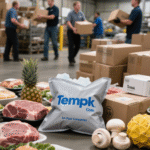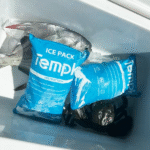Trockeneispackungsgruppe (2025): Wie man baut, Bestätigen & Scale Frozen Shipping
Zuletzt aktualisiert: August 8, 2025 • Reading time: 9–12 min

1) What a “Trockeneispackungsgruppe” Is—and Why It Matters
A Trockeneispackungsgruppe is a cross‑functional capability that designs, qualifies, and runs compliant frozen shipments at scale. It combines: (1) Regulatory ownership, (2) Thermal design & Validierung, (3) Sops & Ausbildung, (4) Anbieter & carrier management, Und (5) Operational analytics for melt‑rate and OTD.
This article synthesizes best practices and field patterns highlighted across your three drafts (team roles, SOP templates, procurement and local intent coverage).
2) Regulatory Ground Truth (2025)
Classification & Grenzen
-
UN -Nummer & Gefahrenklasse: UN1845 – Carbon dioxide, solide (Trockeneis), Klasse 9; no packing group assigned in the HMR entry.
-
Lufttransporte (Iata): Governed by Packanweisung 954. Der Iata 2025 Checkliste zur Akzeptanz von Trockeneisakzeptanz (66th DGR) requires UN number, richtiger Versandname, Und Netto -Trockeneis in kg auf dem Luftwaybill. Typisch quantity limit is 200 kg pro Paket; always check State/Operator variations.
-
UNS. HMR ventilation & Markierungen: Packages must be designed to CO₂ Wind; vessel/vehicle markings are specified in 49 CFR §173.217.
-
Domestic postal reference: USPS PI 9A caps dry ice in domestic air mail at 5 lb (≈2,27 kg) pro Poststück (for context; carriers differ).
Notiz: Some secondary sources misstate “PG III” für Trockeneis; this is incorrect for UN1845. Your new SOPs should reflect “Class 9, no PG,” and PI 954 (not “PI9700”).
Passenger baggage exception (for awareness)
Passagiere können bis zu 2.5 kg of dry ice in checked/hand baggage under IATA personal baggage provisions, provided venting and marking. This does nicht apply to cargo operations but helps explain airline‑level constraints.
3) People, Roles & SOP (Your Operating Model)
Core roles
-
DG Compliance Lead: Owns IATA/IMDG/49 CFR interpretations, change‑log, and acceptance checklists.
-
Thermal Packaging Engineer: Calculates heat load, selects insulation and dry ice mass, and drives ISTA 7E qualification.
-
Operations Supervisor: Trains packers, enforces labeling, runs re‑icing cadence, monitors exceptions.
-
Beschaffung & Qualität: Approves suppliers (dry ice pellets/blocks, VIP sets), keeps SDS and COAs current.
-
Daten & CX: Tracks INP/LCP/CLS on key pages, local SEO footprint, and customer feedback loops.
SOP (excerpt)
-
Verify contents (non‑DG vs DG) and lane → select PI 954 flow.
-
Choose box & Isolierung; hinzufügen entlüftet primary and overpack.
-
Compute dry ice mass (see §4).
-
Pack, markieren & Etikett (Klasse 9 für Luft) and AWB entries (UN1845 + Eigenname + Netz kg).
-
Acceptance self‑check using Iata 2025 Dry Ice Checklist.
-
Handover; record net dry ice and time‑to‑melt assumptions.
4) Pack‑Out Design & Validierung
4.1 Materialien & Configuration
-
Isolierung:
-
EPS/EPP/PUR: wirtschaftlich, moderate R‑value; larger ice loads.
-
VIP -Versender: center‑of‑panel conductivity around 0.004–0.008 W/m·K vs PUR ~0.02–0.03 W/m·K (≈4–6× better), enabling longer holds or smaller cube.
-
-
Containment: Use durable corrugated or molded outer, nicht luftdicht verschließen; the system must Entlüftung Co₂.
4.2 How to Size Dry Ice (engineering shorthand)
-
Heat load ≈ U·A·ΔT·t + infiltration + door/opening losses.
-
Rule of thumb for sublimation energy: ~571 kJ/kg (derived from NIST ΔH_sub ≈ 25–27 kJ/mol). Use your chamber profile to back‑solve required kg.
4.3 Qualifikation
-
Execute lab & field cycles against ISta 7e (72/144 h heat/cold profiles). For certification or audited documentation, anwenden Standard 20 with 7E.
5) Annahme, Markierung & Beschriftung (Luft)
Before tender:
-
Bestätigen max net dry ice per package against PI 954 (Typischerweise 200 kg), check State/Operator variations and aircraft constraints.
-
Auf der Auf Waybill, enthalten: UN1845, „Kohlendioxid, solid” or “Dry ice,” Anzahl der Pakete, Und net weight of dry ice in kilograms.
-
Auf dem Paket: Klasse 9 Etikett (Luft), richtiger Versandname, UN1845, Netz kg; sicherstellen Entlüftung. (FedEx 2025 job aid reflects the same 200 kg/package ceiling and marking details.)
6) Sicherheit & Ausbildung
-
Co₂ -Exposition: Follow OSHA exposure guidance—typical Von 5,000 PPM TWA; STEL ≈ 30,000 ppm (per NIOSH/agency guidance). Ventilate and monitor confined spaces.
-
Handhabung: Erfrischungsrisiko; use cryo‑gloves and tongs. Never place dry ice in versiegelt Behälter.
-
Air ops: Operators may limit total aircraft dry ice loading; disclose net weights during booking per operator variations.























